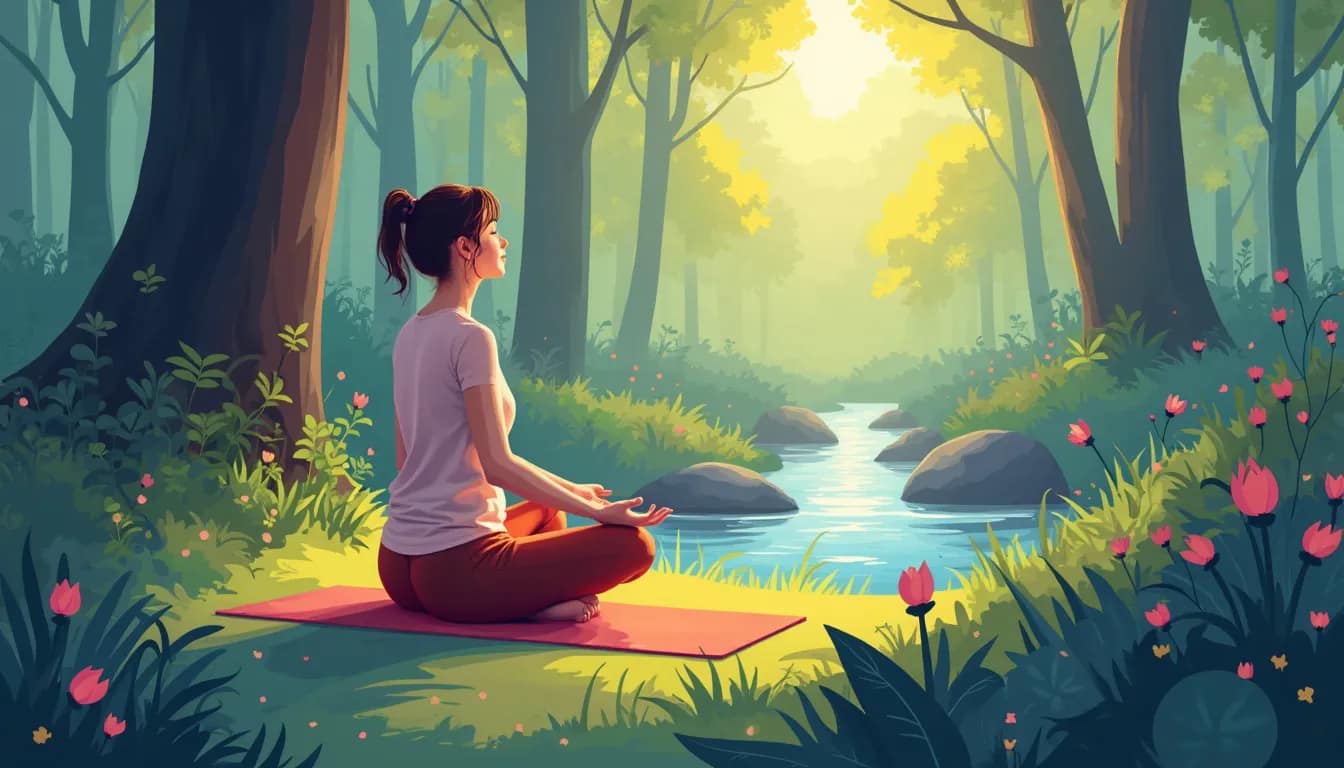Anxiety is a common and often overwhelming experience that affects millions of people worldwide. From the constant worry about everyday responsibilities to the more intense fears that disrupt day-to-day life, anxiety manifests in various forms and touches every corner of our lives. It’s important to acknowledge that you’re not alone in this struggle, and more crucially, there are effective ways to manage and alleviate these feelings. One powerful approach that offers hope and relief is the practice of mindfulness.
Mindfulness, an age-old practice rooted in ancient meditation traditions, has gained significant recognition for its ability to calm the mind and soothe the soul. At its core, mindfulness is about staying present and fully engaging with the here and now, without judgment. This simple yet profound practice cultivates a greater awareness of our thoughts, emotions, and bodily sensations, offering a pathway to inner peace and balance. Scientific research has increasingly endorsed mindfulness as a potent remedy for anxiety, highlighting its capacity to reduce stress, enhance emotional resilience, and improve overall well-being.
In this article, we will explore how mindfulness can be a lifeline for those struggling with anxiety. We will delve into several mindfulness techniques that are specifically tailored to ease anxiety and provide practical tips for incorporating these practices into your everyday life. By adopting these methods, you can learn to navigate the waves of anxiety with greater ease and find a sense of calm amidst the chaos. Whether you’re new to mindfulness or looking to deepen your practice, this guide aims to provide supportive and compassionate insights to help you on your journey towards a more mindful and anxiety-free life.
Introduction to Anxiety and Mindfulness
Anxiety is a universal experience, affecting millions of people worldwide. At its core, anxiety is a natural response to stress, often feeling like a persistent worry or fear about the future. When this feeling becomes overwhelming and persistent, it can evolve into an anxiety disorder. According to the World Health Organization (WHO), almost 264 million people globally live with anxiety disorders, making it a prevalent mental health challenge in our modern society.
If you’ve ever felt anxious, you’re certainly not alone. The quickening of your heartbeat, the racing thoughts, and the stream of worries are shared experiences. It’s important to acknowledge these feelings and approach them with kindness and understanding. Here, mindfulness offers a beacon of hope. By grounding ourselves in the present moment, we can gently steer away from the clutches of anxiety.
Understanding Mindfulness and Its Origins
Mindfulness is the practice of bringing one’s attention to the present moment without judgment. It stems from ancient Eastern philosophies, particularly Buddhism, but has been embraced in secular contexts, particularly in Western cultures, for its mental health benefits. Jon Kabat-Zinn, a pioneer in this field, describes mindfulness as paying attention in a particular way: on purpose, in the present moment, and non-judgmentally.
Incorporating mindfulness doesn’t require any special equipment or lengthy preparation. It’s about cultivating awareness and presence, whether you’re doing the dishes, taking a walk, or even sitting quietly. The simplicity of mindfulness is one of its greatest strengths.
One personal story of mindfulness involves Sarah, a busy mother of three who often felt overwhelmed by anxiety. I used to feel like I was drowning in my own thoughts, she shares. But practicing mindfulness helped me focus on my breath and grounded me in the present moment. This simple act created a ripple effect of calm in my daily life.
The Connection Between Mindfulness and Anxiety Relief
Mindfulness can significantly alleviate anxiety through several mechanisms. By focusing on the present, we can detach from the relentless cycle of “what-ifs” that fuel anxiety. Research by the American Psychological Association (APA) has shown that mindfulness can reduce the symptoms of anxiety by decreasing ruminative thinking and improving emotional regulation. It helps us create a buffer against stress by promoting relaxation and a balanced perspective.
One engaging way to explore the connection between mindfulness and anxiety relief is through a simple interactive exercise. Take a moment right now to try this:
- Pause. Take three deep breaths, feeling the rise and fall of your abdomen.
- Now, close your eyes if you feel comfortable doing so. Notice the sensations in your body, starting from your head and moving down to your toes.
- If your mind starts to wander, gently redirect your focus back to your breath and the sensations you’re experiencing.
- Spend 1-2 minutes in this exercise, noticing how your body and mind feel afterward.
How did that feel? This simple exercise can be a powerful tool in managing anxiety. By taking a few minutes each day to practice mindfulness, you can build resilience against anxiety, fostering a sense of peace and balance.
Through the practice of mindfulness, you can gently create a space where anxiety is no longer the driving force. It becomes possible to experience life’s moments with clarity and calm, nurturing a sense of well-being that permeates every aspect of your existence. Remember, each mindful breath is a step towards a more peaceful self.
Effective Mindfulness Techniques for Managing Anxiety
Anxiety can often feel overwhelming, but mindfulness offers us a gentle path to rediscovering inner calm. Let’s explore some effective mindfulness techniques that can help in managing anxiety:
Deep Breathing Exercises and Their Impact on the Nervous System
One of the simplest yet most powerful mindfulness techniques is deep breathing. This practice can trigger the body’s relaxation response, calming the nervous system and reducing anxiety. To practice deep breathing, follow these steps:
- Find a comfortable sitting or lying position.
- Place one hand on your abdomen and the other on your chest.
- Take a slow, deep breath in through your nose, allowing your abdomen to rise. Feel the air fill your lungs.
- Exhale slowly through your mouth, letting your abdomen fall. Try to make your exhalation slightly longer than your inhalation.
- Repeat this process for 5-10 minutes, focusing on the sensation of your breath.
Reflection: Try taking five deep breaths right now and notice any changes in your mind and body.
Guided Meditation Practices for Anxiety Reduction
Guided meditations can be particularly effective for those struggling with anxiety. These practices often involve a recorded voice that leads you through a meditation, offering a focal point and structure that can help ease worry. Here are a few types of guided meditations that may benefit you:
- Body Relaxation Meditation: This practice involves focusing on each part of your body, from the toes to the head, systematically relaxing each area. This can help to release built-up tension and bring a sense of calm.
- Visualization Meditation: Imagine yourself in a peaceful place – it could be a beach, a forest, or another serene environment. Allow yourself to experience the sights, sounds, and smells as if you are truly there.
- Loving-Kindness Meditation: This meditation encourages you to send love and kindness to yourself and others. Repeating phrases like May I be safe and May I be happy can foster a sense of peace and reduce anxiety.
Practice Suggestion: Set aside just 10 minutes today to try a guided meditation. You can find many free resources online or through mindfulness apps.
Mindful Movement and Body Scans as Tools for Anxiety Management
Movement-based mindfulness practices such as yoga or tai chi integrate physical activity with mindfulness, promoting both mental and physical well-being. These practices encourage awareness of the body and breath, which can anchor your mind in the present moment, reducing anxiety. Consider incorporating the following:
Yoga and Tai Chi
Engaging in these activities helps to synchronize breath and movement, fostering a state of flow that can be incredibly soothing. You don’t need to be an expert to start benefiting; many beginner-friendly classes and online tutorials are available.
“The rhythm of the body, the melody of the mind, and the harmony of the soul create the symphony of life.” – B.K.S. Iyengar
Exercise: Next time you feel anxious, try a simple yoga pose like child’s pose or a basic tai chi sequence. Focus on your breath and how your body moves.
Body Scans
A body scan meditation is another useful tool. This technique involves mentally scanning your body from head to toe, bringing mindful awareness to each part. It helps you tune into sensations and release physical tension. Here’s a brief guide:
- Lie down comfortably on your back with your arms at your sides.
- Close your eyes and take a few slow, deep breaths.
- Start by focusing on the toes of your right foot. Notice any sensations – warmth, coolness, tension, or relaxation.
- Continue gradually moving your focus up through each part of your body.
- If your mind wanders, gently bring it back to the part of the body you were focusing on.
- Complete the scan by reaching the top of your head. Take a few moments to lie still and experience the entire body’s sensation.
Interactive Moment: Set a timer for 5 minutes and attempt a body scan. Reflect on how you feel before and after.
Each of these techniques offers a unique path toward managing anxiety through mindfulness. By incorporating them into your routine, you can create a more peaceful and balanced life, step by step.
Practical Tips to Incorporate Mindfulness into Daily Life
Integrating mindfulness into your daily life need not be overwhelming or complicated. It can be seamlessly woven into your routine, allowing you to experience its calming effects regularly. Below are some practical tips to help you cultivate mindfulness in a way that fits your lifestyle.
Establishing a Daily Mindfulness Routine
One of the most effective ways to make mindfulness a part of your life is by establishing a daily routine. Consistency is key to experiencing the benefits of mindfulness. Here are some suggestions to help you get started:
- Morning Mindfulness: Begin your day with a brief mindfulness exercise. This could be as simple as taking five minutes to sit quietly, focus on your breath, and set a positive intention for the day. This practice can help you start your day with a clear and centered mind.
- Mindful Moments: Incorporate short mindfulness breaks throughout your day. For example, take a moment to close your eyes and take a few deep breaths before starting a new task. This can help you maintain a sense of calm and focus amidst a busy schedule.
- Evening Reflection: End your day with a mindfulness practice. Spend a few minutes reflecting on the positive moments of the day, noticing how you feel, and expressing gratitude. This can help you unwind and prepare for a restful night’s sleep.
Using Mindfulness Apps for Ongoing Support
In today’s digital age, numerous mindfulness apps can provide support and guidance on your mindfulness journey. These apps offer a variety of features, including guided meditations, reminders, and progress tracking. Some popular apps include:
- Headspace: Known for its user-friendly interface and diverse meditation options, Headspace provides guided sessions for stress, anxiety, and sleep enhancement.
- Calm: This app offers a range of calming sounds, guided meditations, and sleep stories to help you relax and unwind.
- Insight Timer: A free app that boasts a large library of guided meditations from teachers around the world, as well as ambient sounds for relaxation and focus.
Using these apps can make it easier to stay committed to your mindfulness practice, even on the busiest days.
Encouraging Mindfulness Practices in Various Settings: Work, Home, and Social Environments
Mindfulness is not limited to formal meditation sessions; it can be practiced in various settings throughout your day. Here are some ways to incorporate mindfulness into different aspects of your life:
At Work:
Work environments can be stressful, but mindfulness can help you stay grounded and focused. Try these simple strategies:
- Mindful Communication: Practice active listening during meetings or conversations. Focus entirely on the speaker without planning your response. This can improve your communication skills and reduce misunderstandings.
- Desk Meditation: Take short breaks to close your eyes and take deep breaths. Use these moments to release stress and refocus your mind.
- Body Awareness: Pay attention to your posture and make sure you’re sitting comfortably. Periodically stretch or do gentle movements to relieve physical tension.
At Home:
Your home environment can be an oasis of calm and tranquility if you incorporate mindfulness into your daily routines:
- Mindful Eating: Pay attention to the colors, textures, and flavors of your food. Eat slowly, and savor each bite. This practice can help improve digestion and increase satisfaction with meals.
- Mindful Household Chores: Transform routine tasks, like washing dishes or folding laundry, into mindfulness exercises. Focus on the sensations and movements involved, and observe your thoughts without judgment.
- Family Mindfulness: Engage in mindfulness activities with your family, such as a short meditation or a mindful walk. This can strengthen bonds and promote a peaceful home atmosphere.
In Social Environments:
Mindfulness can also enhance your interactions with others and help you navigate social situations with more ease:
- Mindful Listening: Give your full attention to the person you are talking to, without interrupting or thinking ahead. This fosters deeper connections and mutual understanding.
- Gratitude Practice: Express appreciation for the people around you. Acknowledge their positive qualities and contributions. This can uplift your mood and create a positive social environment.
- Presence in Social Gatherings: Instead of getting lost in thoughts or distractions, be fully present during social events. Engage genuinely with others and enjoy the moment.
Remember, mindfulness is a practice that develops over time. By incorporating these simple tips into your daily life, you can gradually cultivate a more mindful approach to living, reducing anxiety, and enhancing overall well-being. Try implementing one or two strategies to start, and observe how they positively impact your mind, body, and spirit.
As we conclude our exploration of how mindfulness can be a powerful ally in overcoming anxiety, it’s essential to recognize that the journey you are on is both unique and profoundly personal. Anxiety can often feel like an unwelcome shadow, but by embracing mindfulness techniques, you have the opportunity to transform this experience into one of growth and resilience.
Remember, incorporating techniques such as deep breathing exercises can immediately calm your nervous system, offering a moment of peace during turbulent times. Guided meditation practices help you cultivate a sense of inner calm and presence by gently redirecting your focus away from anxious thoughts. Engaging in mindful movement and body scans allows you to reconnect with your body and break the cycle of anxiety by grounding yourself in the present moment.
To bring mindfulness into your everyday life, consider starting with small, manageable steps. Establishing a daily practice, no matter how brief, can create a consistent refuge of tranquility amidst the busyness of life. Mindfulness apps can serve as helpful companions, providing guided sessions and reminders to keep you on track. Don’t hesitate to weave mindfulness into different aspects of your daily routine, whether it’s taking a mindful pause at work, practicing gratitude at home, or simply being fully present in social interactions.
Your path to managing anxiety with mindfulness is a testament to your strength and commitment to well-being. It’s important to celebrate the progress you make, no matter how small it may seem. Every mindful breath, every moment of connection with the present, and every act of self-compassion is a step towards a more peaceful and balanced life.
As you move forward, know that you are not alone. Many have walked this path and found solace in mindfulness, and their stories echo the transformative power of simply being present. Be gentle with yourself, acknowledge every victory, and cherish the serenity that mindfulness can bring into your life. May your journey be filled with moments of clarity, peace, and profound self-discovery.



